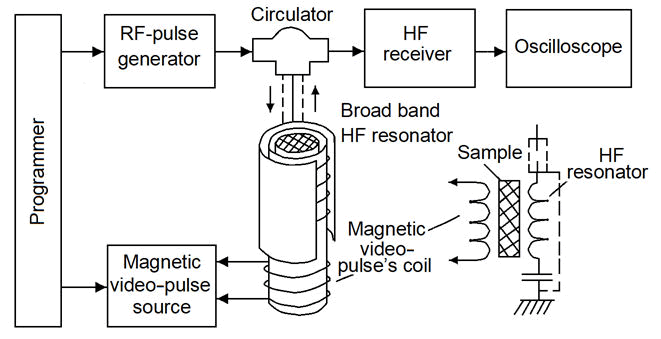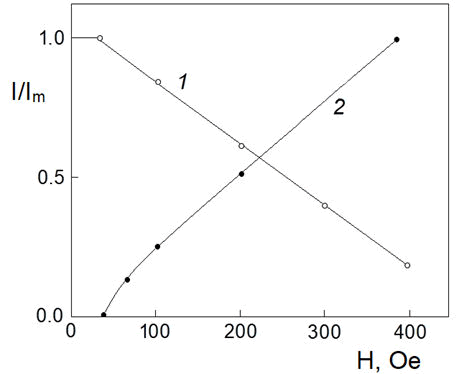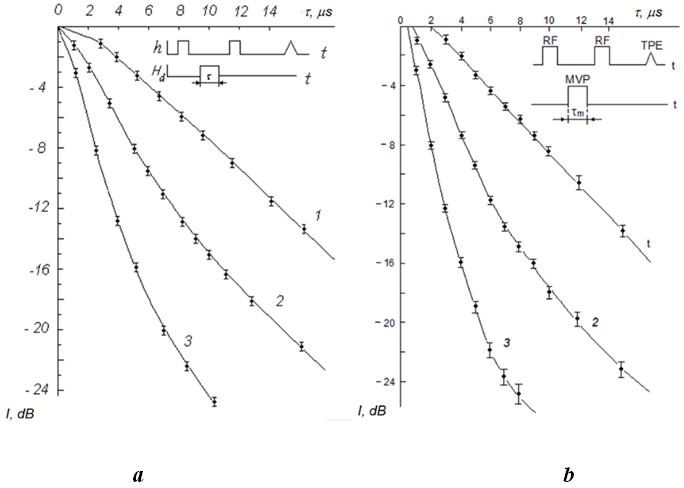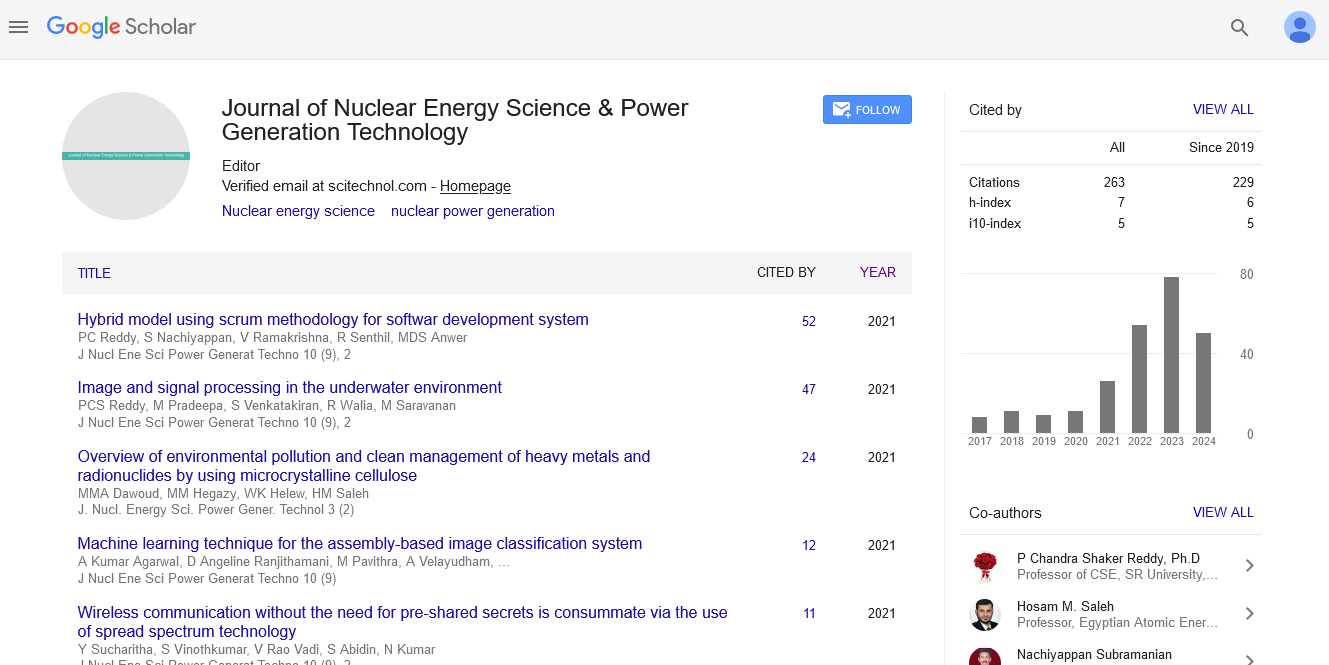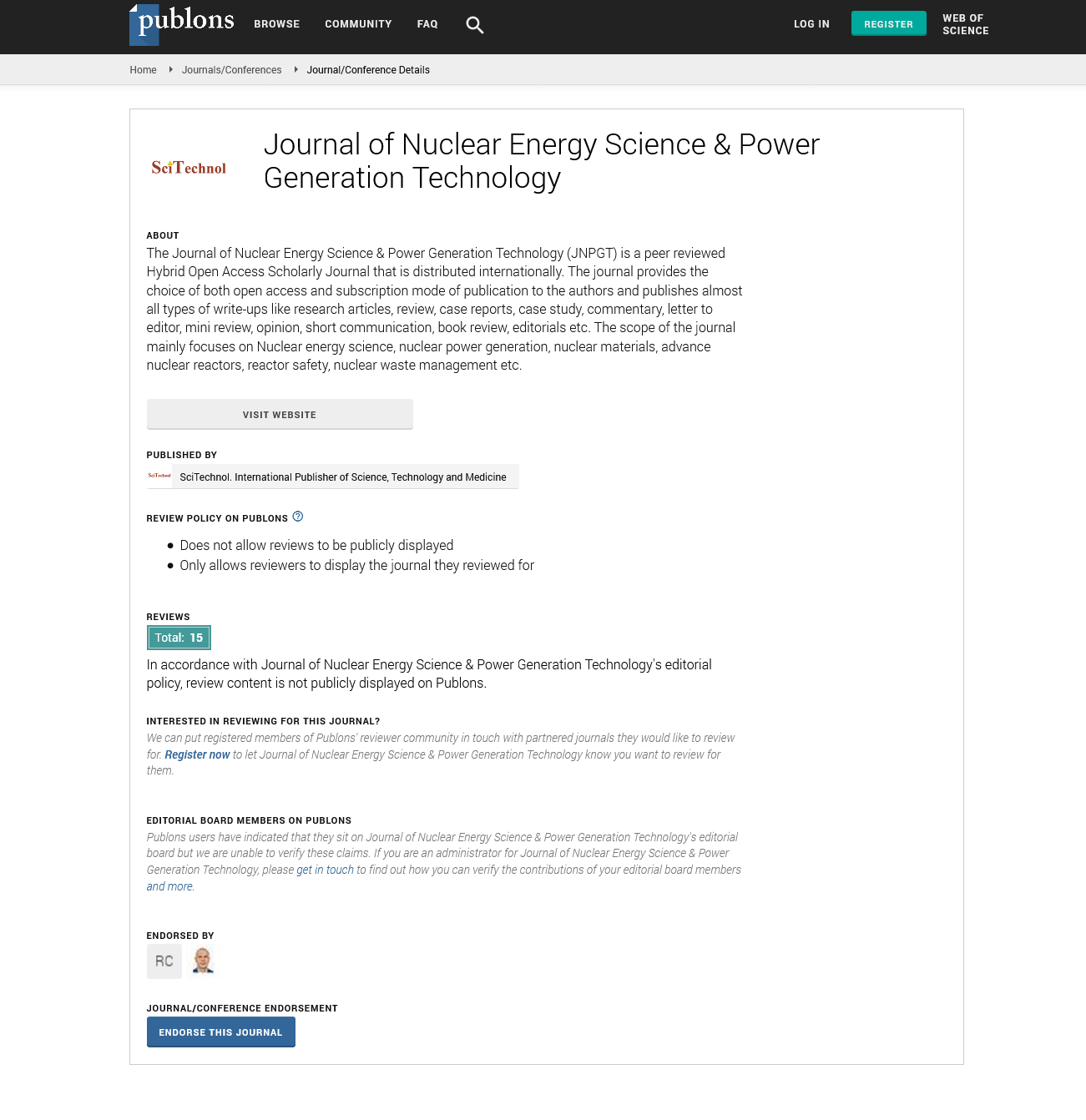Research Article, J Nucl Ene Sci Power Generat Technol Vol: 13 Issue: 5
On the Two Alternative Methods for Estimating the Pinning Force of Domain Walls in Cobalt by the NMR Spin-Echo Method
GI Mamniashvili1*, TO Gegechkori1 and TA Gavasheli2
1Department of Physics, Ivane Javakhishvili Tbilisi State University, Andronikashvili Institute of Physics, 0179 Tbilisi, Georgia
2Department of Electrical and Electronics Engineering, Ivane Javakhishvili Tbilisi State University, 0126 Tbilisi, Georgia
*Corresponding Author: GI Mamniashvili
Department of Physics, Ivane Javakhishvili Tbilisi State University, Andronikashvili Institute of Physics, 0179 Tbilisi, Georgia
E-mail: mamniashviligrigor@gmail.com
Received date: 21 December, 2023, Manuscript No. JNPGT-23-123257;
Editor assigned date: 23 December, 2023, PreQC No. JNPGT-23-123257 (PQ);
Reviewed date: 06 January, 2024, QC No. JNPGT-23-123257;
Revised date: 16 January, 2025, Manuscript No. JNPGT-23-123257 (R);
Published date: 23 January, 2025, DOI: 10.4172/2325-9809.1000434
Citation: Mamniashvili GI, Gegechkori TO, Gavasheli TA (2025) On the Two Alternative Methods for Estimating the Pinning Force of Domain Walls in Cobalt by Cobalt by the NMR Spin-Echo Method. J Nucl Ene Sci Power Generat Technol 14:1.
Abstract
Two alternative NMR spin-echo methods under the influence of an additional magnetic video-pulse were applied to study pinning force in cobalt. The first one uses the action of a magnetic video-pulse on a two-pulse echo signal and the second one–the combined action of an RF and magnetic video pulse, leading to the appearance of an edge single-pulse echo signal. The possibility of measuring the pinning force of domain walls in cobalt was comparatively studied by these methods. The data obtained also make it possible to modify some earlier obtained results on the effect of an additional magnetic video pulse on the nuclear spin-echo signals in magnets, taking into the account of the pinning force of domain walls.
Keywords: NMR, Cobalt, Single-pulse echo, Two-pulse echo, Magnetic video-pulse, Domain wall, Distortion mechanism, Pinning, Ferrite
Introduction
Investigations of the magnetism and magnetic materials play an extremely important role in the development of modern science and technology [1].
Nuclear Magnetic Resonance (NMR) in magnetically ordered materials was first observed by Gossard and Portis in ferromagnetic cobalt [2]. After this, the NMR of nuclei in the magnetic materials became one of the most powerful methods for studying magnetism. It has become possible using NMR to study the static and dynamic characteristics of local atomic systems in ferromagnetic particles, which are difficult to obtain by other methods. The main difference between magnetic materials and non-magnetic ones is the presence of a huge local magnetic field acting on the nuclei.
The main contribution to this local field is due to the effective Hyperfine Field (HFF) acting on the nuclei and arising due to the polarization of s-electrons by the spontaneous magnetization of the ferromagnet through the Fermi contact interaction.
The existence of HFF on nuclei makes it possible to observe NMR in the absence of an external magnetic field, which is necessary in non-magnetic materials. This field reaches values of the order of 105-106 Oe.
Materials and Methods
NMR detection in magnetic materials is facilitated by the fact that the Radio-Frequency (RF) field acts on the nuclei indirectly by changing the electronic magnetization. This leads to the appearance of a resonant field on the nucleus, enhanced by an amplification factor of ηd∼102 in domains and of the order of ηw∼104 in Domain Walls (DWs).
For this reason, a feature of NMR in magnetic materials is that usually the main contribution to the intensity of resonant absorption is due to nuclei located in the DWs due to the large values of the factor ηw for them.
Since the DW is easily displaced when exposed to an additional Magnetic Video-Pulse (MVP), its use is a convenient method for studying the pinning and mobility of the DW, as well as the formation of additional echo signals that arise under the combined influence of RF and MVP [3].
For the first time, the dynamics of DWs in a single-crystal ferrite sample grown in the form of a frame under the action of MVP was studied by Gault [4].
The movement of the DW was induced by the action of the MVP supplied to a primary coil wound on one side of the frame, and the induction signal arising from the movement of the DW was recorded by a second coil wound on the opposite side of the frame and observed on the oscilloscope screen.
It is shown that the dynamics of the DW is described by the linear dependence of the DW speed υ on the amplitude of the applied MVP pulse H:
υ=S (H-H0) (1)
Where S is the mobility of the DW, and the pinning force ÐÂÂÂÂÂ0 is the critical field below which the DW is fixed. Since the external RF field acts on the nuclei through the electronic subsystem, the explanation of the phenomena under consideration should be based on the idea of the movement of the electronic magnetic moments M in the DW under the influence of MVP. The DW displacement, even insignificant, may be accompanied by a large rotation of M. In this case, the angle of rotation of M inside the DW is proportional to the displacement of the DW. This process is accompanied by a change in the HFF on the nuclei, proportional to the displacement of the DW, which is due to the anisotropy of the HFF in magnetic materials.
In recent years, the ability to control magnetization switching in structures with micrometer and submicron scales has rapidly developed, which has allowed us to take a new look at magnetization reversal processes. Such research is relevant to applications for use in Magnetoresistive Random-Access Memory (MRAM) systems. DW displacement is one of the most promising methods for switching local magnetization. The dynamics of DWs in closed structures are of fundamental interest and have direct technological relevance to recently developed magnetic logic systems and are of particular interest when the width of the magnetic structure approaches the width of the DW [5].
The effect of the DW displacement under the action of MVP was first studied by NMR in ferromagnetic metals (Fe, Co, Ni) in [6]. When the MVP was exposed simultaneously with the second RF pulse (the case of the so-called symmetrical effect), the amplitude of the echo signal was decreased. This was interpreted as a consequence of the displacement of the DW by the MVP, with the result that only a fraction of the nuclei excited by the first RF pulse experiences both RF pulses. When the MVP acted in the interval between RF pulses (the case of asymmetrical exposure), the echo signal decreased in the proportion to the product of the amplitude of the MVP and its length, that is, proportionally to the area of the RF pulse.
The decreasing of the echo signal was due to an inhomogeneous shift in the NMR frequency on the nuclei when the DW was displaced due to the anisotropy of the HFF in the DW. Subsequently, this method was used to study the effect of MVP on the nuclear spin echo in some ferro and ferromagnets [7].
In [3], it was found that the critical value of the MVP amplitude, corresponding to the tearing off the DW from the pinning centers, is also determined by its area.
Under the action of the applied MVP, the DW is rapidly accelerated to a speed of several hundred m/s. There is a tendency to find ways to further increase these speeds in order to increase the speed of information processing in memory and logic systems.
However, in earlier works [7,8], the experimentally obtained dependences of the echo signal intensities on the amplitude of the MVP were extrapolated so that the displacement of the DW under the influence of the MVP occurs already at H=0, and not at the amplitude of the MVP, which in this case determines the pinning force of the DW in a given magnet.
This work shows the possibility of modifying the results of these works, taking into account the DW pinning force by the two different NMR methods. The first method uses the study of the asymmetrical MVP influence on the TPE intensity, while the second one uses the alternative method for studying the dependence of the so-called Edge Single-Pulse Echo (ESPE) on the amplitude of the MVP.
As is known, when a single RF pulse is applied to nuclei in the cobalt DWs, a SPE signal appears. The SPE signal is formed by the edges of the RF pulse due to the mechanism of RF pulse distortion [9]. In this case, the edges of the RF pulse play the role of two RF pulses in the TPE Hahn technique. The ESPE is formed under the influence of an additional MVP acting near the trailing edge of a sufficiently long RF pulse. The RF pulse length was chosen to be long enough so that the SPE signal was not observed. In this case, only the ESPE signal is studied, formed by the combined action of the MVP and the trailing edge of the RF pulse.
Results and Discussion
The measurements were carried out on a phase-incoherent spin echo spectrometer in the frequency range 200-400 MHz at a temperature of 77 K [10]. In this range, a commercial Lecher-type generator with a two-wire line was used, including two inductors with different numbers of turns. For pulse lengths in the range from 0.1 to 50 μs, the maximum amplitude of the RF field obtained on the sample was about 3.0 Oe, and the slope of the fronts was no worse than 0.15 μs. Rseceiver dead time ~1 μs.
The scheme of the pulsed impact experiment is shown in Figure 1.
Figure 1: The experimental setup.
The pulsed magnetic field was created by a gated current stabilizer of adjustable amplitude and an additional copper coil, which made it possible to obtain magnetic field pulses of the order of 500 Oe with a sample size of ~10 mm.
Schemes of MVP effect on the TPE and ESPE signals are shown in Figure 2.
Figure 2: a) Scheme of the effect of a Magnetic Video-Pulse (MVP) on a Two-Pulse Echo (TPE) with asymmetrical exposure to the MVP. b) Scheme of excitation of an Edge Single-Pulse Echo (ESPE) at combined RF and MVP excitation.
Figures 3a and 3b show oscillograms of TPE and ESPE signals in cobalt under the combined influence of RF and MVP pulses.
Figure 3: a) Oscillogram of the TPE signal in cobalt (upper beam), the lower beam is the signal from the wavemeter, showing the position of the RF and MVP pulses. b) Oscillogram of the ESPE signal formed in cobalt by the combined action of the MVP and the trailing edge of the long 50 μs RF pulse.
Let us present the results of a study of the pinning force H0 under the influence of an additional MVP on TPE signals depending on the duration of the MVP τm in cobalt, Figures 5a and b shows the corresponding dependences of the ESPE intensities on the duration of the MVP.
Figure 4 shows the dependences of the normalized intensities I/Im of TPE and ESPE, with the asymmetrical impact of MVP on TPE, and the joint action of RF and MVP during the formation of ESPE.
Figure 4: The dependences of the normalized intensities I/Im of TPE (1) and ESPE (2) signals on the amplitude of the MVP with a length τm=1 μs.
Let us present the results of a study of the pinning force H0 under the influence of an additional MVP on the TPE signals depending on the duration of the MVP τm in cobalt, Figures 5a and b shows the corresponding dependences of the ESPE intensities on the durations of the MVP.
Figure 5: a) Dependence of the normalized intensities I/Im of the TPE on the amplitude of the MVP H: (1-3) at τm=1, 2 and 3 µs, respectively. b) Dependences of the normalized intensities I/Im of the ESPE signals on the durations of MVPs with lengths τm=1.5, 1 and 0.5, (1-3) respectively.
Analysis of the obtained results in Figure 5 shows that in the case of cobalt the relation is satisfied, where Am is the area of MVP, according to which the threshold area of the MVP is constant for all durations of the MVP.
Am=H0τm=const 2
This coincides with a similar conclusion for the modified threshold areas of the MVP in the case of nickel ferrite.
The dependence of the amplitude of the TPE (A-nodes of nickel ferrite) on the duration of an asymmetric MVP obtained in [7] is shown in Figure 6a.
This dependence of the TPE intensity on the MVPs can be modified, as it is shown in Figure 6b, if we take into the account of the influence of DW pinning centers.
Note that in this case relation (2) is also satisfied.
Figure 6: a) The dependences of the amplitudes of the TPE (A nodes of nickel ferrite) on the durations of the asymmetric MVP τm at H=2, 4 and 10 Oe (1, 2 and 3 correspondingly). b) The corresponding modified dependences of the TPE amplitudes (A nodes of nickel ferrite) on the durations τm of the asymmetric MVP.
Similarly, the dependences of the TPE intensities on the amplitude of the MVP in lithium ferrite, obtained in [8] can be also modified.
Figure 7a shows the result of the combined effect of MVP on TPE signals in a zero magnetic field (1) and an external magnetic field He=1000 Oe (2), and Figure 7b shows a modified Figure 7a, taking into account the presence of the pinning force H0, using the same experimental points as in Figure 7a.
Figure 7: a) Dependence of the normalized intensities I/Im of the Two-Pulse Echo (TPE) signal on the amplitude of the Magnetic Video-Pulse (MVP) in lithium ferrite. b) The modified dependences of the normalized TPE amplitude on the MVP amplitude at: 1-He=0 Oe; 2-He=1000 Oe.
Thus, the results of this work make it possible to modify the results of works [7,8], in order to take into account of the influence of pinning forces on the corresponding echo signals.
The results obtained in this work also indicate the possibility of measuring the pinning field of the DWs H0 using the NMR spin-echo method with additional MVP, which is determined by the amplitude of the MVP, below which the DWs are fixed.
It is shown in [4] that the ESPE is formed by the mechanism of distortion of the corresponding fronts of the effective RF pulse. In this case, the decisive role is played by the distortion of the fronts of the effective RF pulse, formed by the influence of the MVP and the trailing edge of the RF pulse, which occurs with a sufficiently rapid displacement of the DWs due to the anisotropy of the HFF and the inhomogeneity of the RF amplification factor η.
The amplitude of the MVP at which the ESPE signal appears correlates with the amplitude of the MVP acting on the TPE, at which it begins to decrease when the amplitude of the MVP H exceeds the pinning force H0. The experimental dependences of the signals ESPE and TPE can be qualitatively understood by accepting that when exposed to MVP, the domain wall reversibly shifts by a distance Δx proportional to the amplitude of the MVP: Δx~υτm=S(H-H0)τm, when the amplitude of the MVP exceeds the pinning force H0. On the nuclei in the Δx layer, under the combined influence of RF and MVP, the magnitudes and directions of the effective magnetic field Heff in the rotating coordinate system change abruptly due to corresponding changes in the local HFF and factor η: Heff=(Δωjz+ω1y)/γn, γn nuclear gyromagnetic ratio; z and y are unit vectors in a rotating coordinate system, Δωj=(ωNMRj-ωpy) detuning of the jth isochromate, ω1=γnηH1 amplitude of the RF field in frequency units, η-F field amplification factor. According to the non-resonant model of SPE formation [9], the impact of MVP is equivalent to the impact of the leading edge of the RF pulse. In this case, the role of the second edge of the RF pulse is played by the trailing edge of the long RF pulse used. In this case, the amplitude of the ESPE is proportional to the number of nuclei in the layer Δx, formed when domain boundaries are displaced: IESPE~Δx/L, where L is the width of the excited section of the domain boundaries when exposed to an RF pulse. In this case, the abrupt change in the NMR frequency in the rotating coordinate system ωj'=(ωjz+ω1y)/γn must satisfy the condition Δωj'τm<<1 or the precession period of nuclei in the rotating coordinate system must be greater than the duration MVP τm. When the MVP influences the TPE in the interval between RF pulses, the condition Δωj'τm<<1 is not satisfied, since RF pulses ωj=γnHHFFj are absent at the moment of the MVP action and the nuclei precess in the local HFF with a frequency ωj=γnHHFFj frequency. Consequently, the condition ωjτm<<1 must be satisfied, requiring a nanosecond duration of the MVP τm, when observing an inverse echo [11], in order to observe additional echo signals formed under the influence of the MVP in the interval between RF pulses, which in our case is not executed. Therefore, the effect of MVP on TPE leads only to a decrease in the intensity of TPE, proportional to the displacement of domain boundaries: ITPE~(L-Δx)/L, due to the loss of phase coherence of nuclei in this layer. This interpretation allows us to qualitatively understand the obtained experimental dependences of the ESPE and TPE signals under the influence of MVP.
Conclusion
Thus, proof is given by two alternative methods when using the spin-echo NMR method: The effect of MVP on the TPE and the combined effect of RF and MVP, leading to the appearance of ESPE, the possibility of measuring the pinning force of DW H0 in cobalt by the NMR method under the influence of additional MVP
The data obtained also make it possible to modify some previously obtained results on the effect of additional magnetic video-pulse on nuclear spin echo signals in magnets, to take into account the domain wall pinning force.
Acknowledgements
The work was carried out with the support of the National Science Foundation of Georgia. Shota Rustaveli (SRNSFG) (STEM).
References
- Guimarães AP, Oliveira IS (1998) Magnetism and magnetic resonance in solids. John Wiley & Sons, Inc., Hoboken, United States.
- Gossard AC, Portis AM (1959) Observation of nuclear resonance in a ferromagnet. Phys Rev Lett 3: 164.
- Mamniashvili GI, Gegechkori TO (2021) Analog of a single-pulse echo signal in cobalt formed by an additional magnetic videopulse. J Appl Spectrosc 88: 965-969.
- Galt JK (1954) Motion of individual domain walls in a nickelâ?ÂÂÂÂÂiron ferrite. Bell Syst Tech J 33: 1023-1054.
- Atkinson D, Allwood DA, Faulkner CC, Xiong G, Cooke MD, et al. (2003) Magnetic domain wall dynamics in a permalloy nanowire. IEEE Trans Magn 39: 2663-2665.
- Weger M, Hahn EL, Portis AM (1961) Transient excitation of nuclei in ferromagnetic metals. J Appl Phys 32: S124-S125.
- Rassvetalov LA, Levitskii AB (1981) Impulse magnetic-field effect on the nuclear-spin echo in some ferromagnets and ferrimagnets. Fiz Tverd Tela 23: 3354-3359.
- Pleshakov IV, Popov PS, KuzminYuI, Dudkin VI (2016) Study of pinning of domain walls of a magnetically ordered material by the nuclear magnetic resonance method. Lett ZhTP 42: 9-15.
- Mamniashvili G, Gegechkori T, Janjalia M, Gogishvili P (2023) Investigation of the single-pulse NMR echo origin in cobalt using additional magnetic video-pulses. Magn Reson Solid 24: 22102-22110.
- Gavasheli TA, Mamniashvili GI, Shermadini ZG, Zedginidze TI, Petriashvili TG, et al. (2020) Investigation of the pinning and mobility of domain walls in cobalt micro-and nanowires by the nuclear spin echo method under the additional influence of a magnetic video pulse. J Magn Magn Mater 500: 166310.
- Ignatchenko VA, Maltsev VK, Reingardt AE, Tsifrinovich VI (1983) A new mechanism for the formation of a nuclear spin echo. JETP Lett 37: 439-440.
 Spanish
Spanish  Chinese
Chinese  Russian
Russian  German
German  French
French  Japanese
Japanese  Portuguese
Portuguese  Hindi
Hindi 